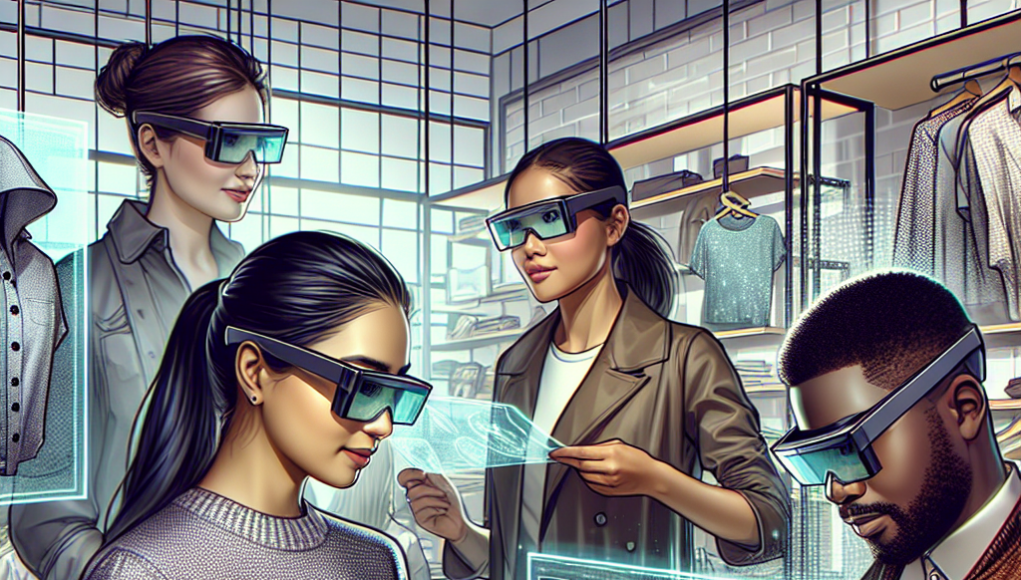In the rapidly evolving landscape of consumer technology, businesses are constantly seeking innovative ways to enhance customer experience and distinguish themselves from competitors. Augmented Reality (AR) has emerged as a powerful tool in this quest, offering a unique blend of the physical and digital worlds. By overlaying digital information onto the real world, AR provides an enriched experience that can transform how consumers interact with brands. This article explores the transformative role of AR in retail, its ability to create interactive shopping experiences, and its impact on bridging the gap between physical and digital services.
Transforming Retail: AR’s Role in Customer Experience
Augmented Reality is revolutionizing the retail sector by offering immersive experiences that captivate customers and enhance their interaction with products. Retailers are leveraging AR to create dynamic and engaging shopping environments, allowing customers to visualize products in their own space before making a purchase. This not only elevates the shopping experience but also empowers consumers with the confidence to make informed decisions.
AR enables retailers to offer personalized experiences by tailoring product information and recommendations to individual customers. By analyzing user data and preferences, AR applications can suggest products that align with a customer’s style, needs, and past purchases. This level of personalization fosters a deeper connection between the consumer and the brand, enhancing customer loyalty and satisfaction.
In-store navigation is another area where AR is making a significant impact. By using AR-enabled apps, customers can easily find products within a store, access detailed product information, and even receive real-time promotions and discounts. This seamless integration of technology into the shopping experience reduces frustration and enhances convenience, ultimately improving overall customer satisfaction.
AR also offers retailers the opportunity to create engaging marketing campaigns that capture the attention of tech-savvy consumers. By integrating AR into advertising, brands can create interactive and memorable experiences that resonate with customers long after they leave the store. This innovative approach to marketing not only increases brand awareness but also drives customer engagement and sales.
Moreover, AR can be used to train retail staff by providing them with interactive tools to better understand products and customer needs. This enhances the quality of customer service and ensures that employees are well-equipped to assist customers effectively. As a result, retailers can maintain high standards of service while simultaneously adopting cutting-edge technology.
Finally, AR technology can help retailers optimize their inventory management by providing real-time data on product availability and demand. This allows for more efficient stocking and reduces the likelihood of overstocking or stockouts, ensuring that customers can always find the products they need. By streamlining operations, retailers can focus on delivering an exceptional customer experience.
Interactive Shopping: Engaging Customers with AR
Interactive shopping experiences, powered by AR, are redefining how consumers engage with products and brands. By offering a more interactive and immersive shopping experience, AR encourages customers to explore products in a way that static images and descriptions cannot achieve. This heightened level of engagement leads to increased interest and a greater propensity to purchase.
One of the most significant benefits of AR in shopping is the ability to provide virtual try-ons. Customers can see how a piece of clothing, accessory, or makeup product looks on them without physically trying it on. This feature not only saves time but also enhances convenience, allowing customers to make confident purchasing decisions from the comfort of their own homes.
AR also facilitates product customization, enabling customers to personalize products to their liking. Whether it’s choosing colors, patterns, or features, AR applications provide a platform for customers to visualize and modify products in real-time. This level of customization fosters a sense of ownership and satisfaction, as customers feel more connected to the products they purchase.
Moreover, AR can transform the way customers interact with product packaging. By scanning a product’s packaging with an AR-enabled device, customers can access additional information, tutorials, and even interactive games. This added layer of engagement not only enriches the customer experience but also provides brands with a unique platform to communicate their values and product benefits.
In addition to enhancing product interaction, AR can be used to create engaging in-store experiences that draw customers in. Retailers can set up AR installations or displays that encourage customers to explore and interact with products in a fun and innovative way. These experiences can increase foot traffic and encourage customers to spend more time in-store, ultimately boosting sales.
Finally, AR technology can be utilized to gather valuable customer insights. By analyzing how customers interact with AR applications, retailers can gain a deeper understanding of consumer behavior and preferences. This data can be used to refine marketing strategies, improve product offerings, and tailor the shopping experience to better meet customer needs.
Bridging Physical and Digital: AR’s Impact on Service
Augmented Reality serves as a bridge between the physical and digital realms, offering businesses a unique opportunity to enhance service delivery. By integrating AR into customer service, companies can provide support that is both efficient and engaging, ultimately improving customer satisfaction.
One of the most impactful applications of AR in service is remote assistance. Through AR, service representatives can provide real-time guidance to customers by overlaying digital instructions onto their physical environment. This capability is particularly useful in technical support, where visual guidance can significantly enhance the troubleshooting process and reduce resolution times.
AR also enables the creation of interactive user manuals and guides. Instead of relying on traditional paper manuals, customers can use AR applications to access step-by-step instructions in a more intuitive and engaging format. This not only simplifies complex processes but also reduces the likelihood of errors, ensuring a smoother customer experience.
In industries such as automotive and home improvement, AR can be used to visualize maintenance and repair tasks. Customers can use AR applications to see virtual overlays of parts and tools, providing a clear understanding of what needs to be done. This hands-on approach empowers customers to perform tasks with confidence, reducing the need for professional intervention and associated costs.
Additionally, AR can enhance the post-purchase experience by providing customers with virtual demonstrations and tutorials. By offering ongoing support and education, brands can ensure that customers derive maximum value from their products. This proactive approach to customer service not only increases satisfaction but also fosters long-term loyalty.
AR also has the potential to transform the way businesses conduct training for their employees. By providing immersive and interactive training programs, companies can ensure that their workforce is well-prepared to deliver exceptional service. This investment in employee development translates into a better customer experience, as knowledgeable and skilled employees are better equipped to meet customer needs.
Finally, AR can facilitate seamless communication between customers and businesses. By integrating AR into communication platforms, companies can offer more dynamic and engaging interactions, whether it’s through video calls, virtual consultations, or interactive chatbots. This enhanced level of communication ensures that customers feel valued and supported throughout their journey with the brand.
As businesses continue to navigate the digital age, Augmented Reality stands out as a transformative force in enhancing customer experience. By merging the physical and digital worlds, AR offers retailers and service providers the tools to engage customers in innovative and meaningful ways. From transforming retail environments to creating interactive shopping experiences and bridging the gap between physical and digital services, AR is reshaping the consumer landscape. As technology continues to advance, the potential for AR to revolutionize customer experience is boundless, promising a future where brands can connect with consumers on a deeper, more personalized level.










